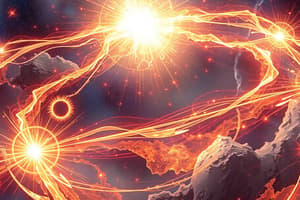Podcast
Questions and Answers
The gravitational______ force is the attraction between masses.
The gravitational______ force is the attraction between masses.
gravitational
Force equals mass times ______.
Force equals mass times ______.
acceleration
The energy of motion is known as ______ energy.
The energy of motion is known as ______ energy.
kinetic
The ______ of energy states that energy cannot be created or destroyed.
The ______ of energy states that energy cannot be created or destroyed.
Mechanical waves require a ______ to travel through.
Mechanical waves require a ______ to travel through.
The formula E=mc² is associated with ______ relativity.
The formula E=mc² is associated with ______ relativity.
In optics, ______ refers to the bending of light as it passes from one medium to another.
In optics, ______ refers to the bending of light as it passes from one medium to another.
The unit of energy is the ______.
The unit of energy is the ______.
The speed of light is approximately ______ m/s.
The speed of light is approximately ______ m/s.
Ohm's Law states that voltage equals current times ______.
Ohm's Law states that voltage equals current times ______.
Flashcards are hidden until you start studying
Study Notes
Key Concepts in Physics
-
Fundamental Forces:
- Gravitational: Attraction between masses.
- Electromagnetic: Interaction between charged particles.
- Weak Nuclear: Responsible for radioactive decay.
- Strong Nuclear: Holds protons and neutrons in the nucleus.
-
Key Laws of Motion (Newton's Laws):
- An object at rest stays at rest, and an object in motion stays in motion unless acted upon by a force (first law).
- Force equals mass times acceleration (F=ma) (second law).
- For every action, there is an equal and opposite reaction (third law).
-
Energy Types:
- Kinetic: Energy of motion.
- Potential: Stored energy based on position.
- Thermal: Energy related to temperature and heat.
- Mechanical: Sum of potential and kinetic energy in a system.
-
Conservation Laws:
- Conservation of Energy: Energy cannot be created or destroyed, only transformed.
- Conservation of Momentum: The total momentum of a closed system remains constant.
-
Types of Waves:
- Mechanical: Requires a medium (e.g., sound).
- Electromagnetic: Can travel through a vacuum (e.g., light).
-
Wave Properties:
- Wavelength: Distance between successive crests.
- Frequency: Number of waves passing a point in one second.
- Amplitude: Maximum displacement from rest position.
-
Thermodynamics:
- First Law: Energy is conserved in processes.
- Second Law: Entropy of an isolated system will always increase.
- Third Law: As temperature approaches absolute zero, entropy approaches a constant minimum.
-
Relativity:
- Special Relativity: Time and space are relative; mass and energy are interchangeable (E=mc²).
- General Relativity: Gravity is the curvature of spacetime.
-
Electricity and Magnetism:
- Ohm's Law: Voltage = Current x Resistance (V=IR).
- Magnetic Fields: Created by moving charges; interact with electric currents.
-
Optics:
- Reflection: Bouncing of light off surfaces.
- Refraction: Bending of light as it passes from one medium to another.
- Lenses: Convex (converging) and concave (diverging) affect light rays.
Key Units of Measurement
- Force: Newton (N)
- Energy: Joule (J)
- Power: Watt (W)
- Electric Charge: Coulomb (C)
- Pressure: Pascal (Pa)
- Temperature: Kelvin (K)
Important Constants
- Speed of Light (c): ~3 x 10^8 m/s
- Gravitational Constant (G): 6.674 x 10^-11 N(m/kg)²
- Planck's Constant (h): 6.626 x 10^-34 J·s
Applications of Physics
- Engineering: Design of structures and machines.
- Astronomy: Understanding celestial bodies and movements.
- Medicine: Imaging technologies (e.g., MRI, X-rays).
- Environmental Science: Energy technology and climate modeling.
Fundamental Forces
- Gravitational Force: Attracts objects with mass.
- Electromagnetic Force: Operates on charged particles.
- Weak Nuclear Force: Responsible for radioactive decay, changes particles into others
- Strong Nuclear Force: Binds protons and neutrons together within the nucleus of an atom.
Key Laws of Motion
- Newton's First Law of Motion: Objects at rest stay at rest, and objects in motion stay in motion at a constant velocity, unless acted upon by a net force.
- Newton's Second Law of Motion: Force is equal to mass times acceleration (F = ma).
- Newton's Third Law of Motion: For every action, there is an equal and opposite reaction.
Energy Types
- Kinetic Energy: The energy of motion.
- Potential Energy: Stored energy based on an object's position or state.
- Thermal Energy: Associated with the temperature of an object.
- Mechanical Energy: The sum of potential and kinetic energy within a system.
Conservation Laws
- Conservation of Energy: Energy cannot be created or destroyed; it can only be transformed from one form to another.
- Conservation of Momentum: In a closed system, the total momentum remains constant.
Types of Waves
- Mechanical Waves: Require a medium (e.g., sound waves travel through air)
- Electromagnetic Waves: Can travel through a vacuum (e.g., light waves can travel through space)
Wave Properties
- Wavelength: The distance between two successive crests or troughs of a wave.
- Frequency: The number of waves passing a point per second.
- Amplitude: The maximum displacement of a wave from its rest position.
Thermodynamics
- First Law of Thermodynamics: Energy is conserved during any process.
- Second Law of Thermodynamics: The entropy of an isolated system always increases over time.
- Third Law of Thermodynamics: As the temperature of a system approaches absolute zero, its entropy approaches a constant minimum.
Relativity
- Special Relativity: Time and space are relative to the observer's frame of reference; mass and energy are interchangeable (E = mc²).
- General Relativity: Gravity is the curvature of spacetime caused by the presence of mass and energy.
Electricity and Magnetism
- Ohm's Law: Voltage is equal to current multiplied by resistance (V = IR).
- Magnetic Fields: Created by moving electric charges and interact with electric currents.
Optics
- Reflection: The bouncing of light off surfaces.
- Refraction: The bending of light as it passes from one medium to another.
- Lenses: Convex (converging) lenses focus light, while concave (diverging) lenses spread light.
Key Units of Measurement
- Force: Newton (N)
- Energy: Joule (J)
- Power: Watt (W)
- Electric Charge: Coulomb (C)
- Pressure: Pascal (Pa)
- Temperature: Kelvin (K)
Important Constants
- Speed of Light (c): Approximately 3 x 10^8 meters per second.
- Gravitational Constant (G): 6.674 x 10^-11 N(m/kg)².
- Planck's Constant (h): 6.626 x 10^-34 J·s
Applications of Physics
- Engineering: The principles of physics are applied for the design of structures, machines, and systems.
- Astronomy: Physics helps us understand celestial bodies and movements.
- Medicine: Imaging technologies like MRI and X-rays rely on physical principles.
- Environmental Science: Physics is critical for understanding energy technology and climate models.
Studying That Suits You
Use AI to generate personalized quizzes and flashcards to suit your learning preferences.




